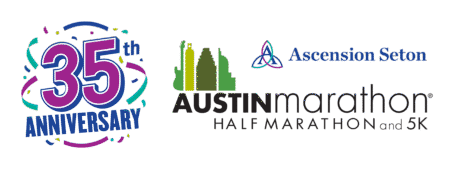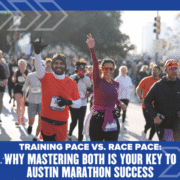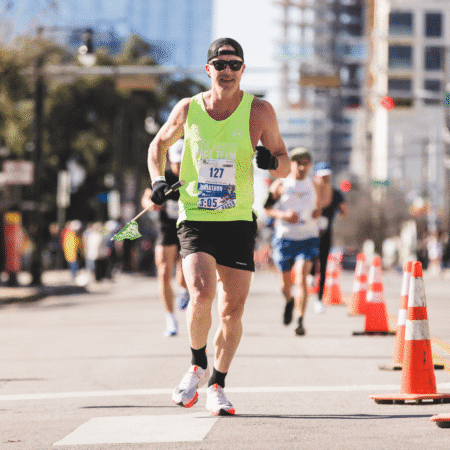Training Pace vs. Race Pace: Why Mastering Both Is Your Key to Austin Marathon Success
Hello, Austin runners! Whether you’re gearing up for your very first marathon or know every pothole on Congress Avenue by heart, one crucial factor can elevate your race day performance: mastering the difference between training pace and race pace.
Let’s dive into these two essential speeds and why both matter for your best Austin Marathon ever!
🏃♀️ What Exactly Is Training Pace?
Simply put, training pace is how fast you run during workouts. However, not every run should feel like you’re racing—most shouldn’t. Training pace varies depending on your workout’s goal. Here’s a quick guide:
- Easy Pace: Comfortable and conversational. Imagine a casual taco run with friends.
- Tempo Pace: A sustained, comfortably hard effort. You’re pushing, but not sprinting.
- Long Run Pace: Slightly slower than your race pace, focusing on building endurance.
- Interval Pace: Short, fast bursts with recovery breaks, designed to enhance speed and strength.
Each of these paces is crucial to ensuring you hit the Austin Marathon start line healthy, strong, and prepared.
🏁 What Is Race Pace?
Race pace is the specific speed you aim to maintain during the marathon itself. It aligns directly with your personal race goals—whether you’re chasing a personal record (PR), aiming to qualify for another race, or simply wanting to finish strong and smiling.
Your ideal race pace depends on several factors:
- Fitness Level: Your current training status.
- Training Consistency: How effectively you’ve prepared.
- Course Terrain: Watch out for those Enfield hills!
- Weather Conditions: Texas weather in February can be full of surprises.
⚖️ Why You Shouldn’t Train at Race Pace All the Time
It’s easy to think: “If I always train at race pace, I’ll ace it on race day.” But training consistently at race pace can lead to burnout or injury.
Instead, aim for balance:
- 80% of your runs: Keep these easy and conversational. Your body will thank you for this aerobic foundation.
- 20% of your runs: Reserve these for tempo, interval, and race pace-specific workouts to build strength, speed, and race readiness.
Think of training like crafting the perfect Austin taco—balanced ingredients make it great; too much spice can burn you out!
🧠 Mental Benefits of Pace Variation
Mixing training paces not only boosts physical performance but also trains your mind:
- Easy Runs: Help build consistency and enjoyment in your routine.
- Tempo and Interval Runs: Teach your mind how to embrace discomfort and maintain focus.
- Race Pace Workouts: Help you understand and internalize your target effort, reducing race-day surprises.
When you’re lined up on Congress Avenue come race day, your mind and body will both be prepared for what’s ahead.
🥑 Austin-Specific Pace Practice Spots
Want to train specifically for the Austin Marathon? Incorporate these local favorites:
- Shoal Creek Trail: Ideal for flat, tempo-paced workouts.
- Enfield Road Hills: Perfect for practicing race-pace efforts and getting comfortable with inclines.
- Lady Bird Lake Hike-and-Bike Trail: Great for scenic long runs—plus a coffee or smoothie afterward for recovery.
🎉 Final Thoughts
Training pace and race pace are like your favorite pair of running shoes—you need the right one for each occasion. By balancing both, you’ll build endurance, avoid burnout, and ensure you’re race-ready on the big day.
Stay consistent, trust your training, and remember: every run counts, not just race day. We can’t wait to see you at the Austin Marathon start line—prepared, strong, and ready to crush your goals!








